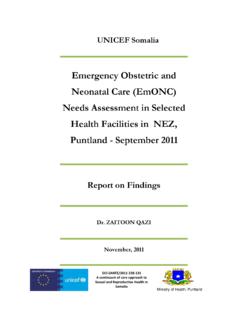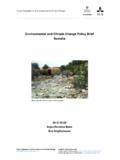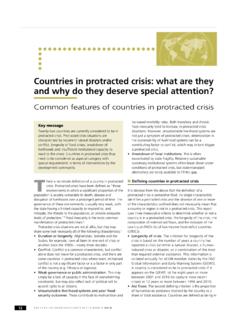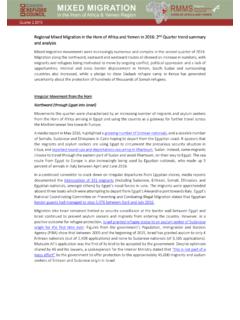Transcription of Integrated Food Security Phase Classifi cation
1 Integrated food Security Phase Classifi cationTechnical ManualVersion Integrated food Security Phase Classification (IPC) Global PartnersIntegrated food Security Phase Classifi cationTechnical ManualVersion to this manual are available at: Global Partners:Funding Agencies:The European UnionThe FAO-Netherlands Partnership ProgramVersion 1 of this manual was prepared by FAO/FSAU in 2006:The food and Agriculture Organization of the United Nations. Rome. 2008 Prepared by the IPC Global PartnersThe designations employed and the presentation of material in this information product do not imply the expression of any opinion whatsoever on the part of the food and Ag-riculture Organization of the United Nations, the IPC Global Partners and the European Union concerning the legal or development status of any country, territory, city or area or of its authorities, or concerning the delimitation of its frontiers or boundaries.
2 The views expressed in this publication are those of the author(s) and do not necessarily refl ect the views of the food and Agriculture Organization of the United Nations, the IPC Global Partners, and the European rights reserved. FAO encourages reproduction and dissemination of material in this information product. Non-commercial uses will be authorized free of charge upon request. Reproduction for resale or other commercial purposes, including educational purposes, may incur fees. Applications for permission to reproduce or disseminate FAO copyright materials and all other queries on rights and licences, should be addressed by e-mail to or to the Chief, Publishing Policy and Support Branch, Offi ce of Knowledge Exchange, Research and Extension, FAO, Viale delle Terme di Caracalla, 00153 Rome, Italy.
3 FAO 2008 Reprinted 2009, 2010 Version 1 of this manual was originally prepared in 2006 by cite this previous version as : FAO/FSAU 2006. Integrated FoodSecurity and Humanitarian Phase Classifi cation : Technical ManualVersion 1. Nairobi, FAO/FSAU Technical Series IVA revised version was published by FAO in cite this current manual as:IPC Global Partners. 2008. Integrated food Security Phase Classifi cation Technical Manual. Version FAO. : 978-92-5-106027-8 IPC Technical Manual Version results from the joint effort of the IPC Global Partners, a group of eight agencies and international NGOs including: Care International, the food and Agriculture Organization of the United Nations (FAO), the Famine Early Warning Systems Network (FEWS NET), the Joint Research Centre of the European Commission (EC-JRC), Oxfam Great Britain, Save the Children UK, Save the Children US, and the United Nations World food Programme (WFP).
4 IPC Technical Manual Version is based on Version 1 which was prepared by FAO /FSAU. Revisions have been conducted on behalf of the IPC Global Partners by the IPC Technical Working Group composed of: Suleiman Mohamed (FEWSNET), Agn s Dhur (WFP), Val rie Ceylon (WFP), Nicholas Haan (FAO) and Cindy Holleman (FSAU/FAO). Nicholas Haan coordinated the revision process and edited this ORIGINAL FOREWORD AND ACKNOWLEDGEMENTS MAY 2006 Since 1994, FSAU has been investing considerable energy in improving the rigour of the unit s food Security , nutrition, and livelihoods analysis, and its relevance for decision making.
5 To help meet the goals of rigor and relevance, FSAU has been developing and using a tool called the Integrated food Security and Humanitarian Phase Classifi cation (IPC) since February 2004. In addition to consistently improving analysis and facilitating effective response in the context of Somalia, there are strong indications that the IPC is relevant on a wider scale, as it serves as a common currency for food Security and humanitarian analysis. This manual provides technical guidance on the use of the IPC for FSAU analysts and technical partners. It will hope-fully contribute to on-going global efforts to standardize core elements of humanitarian analysis and response ( , the SMART, Benchmarking, Needs Analysis Framework, Humanitarian Tracking Service, and Sphere Project).
6 The IPC builds on aspects of many existing classifi cation systems and academic literature. The practical strength of the IPC, however, is that it was developed through the everyday realities of conducting food Security analysis and linking it to action within the context of a complex emergency. In addition, IPC development has benefi ted from technical feedback from expert practitioners and high level decision makers through dozens of forums in Africa, Asia, Europe, and the USA. Appendix A lists just some of these meetings. We are extremely grateful for participants technical FSAU, there has been an on-going technical dialogue on the IPC among all of our Nairobi based analysts in-cluding: Noreen Prendiville, Cindy Holleman, Yusuf Mohamed, Ali Duale, Thomas Gabrielle, Simon Narbeth, Veena Sam-pathkumar, Zainab Jama, James Kingori, Sicily Matu, Ahono Busili, Bernard Owadi, Tom Oguta, Achoka Luduba, Carol Kingori and Francis Barasa.
7 FSAU has a close partnership with FEWS NET Somalia, and both Mohamed Aw-Dahir and Sidow Addou have been directly involved in the IPC development. FSAU fi eld staff has also made substantial input. Special thanks to Cindy, Noreen, Thomas, and Veena for their technical editing of this you to the FSAU technical partners from WFP, UNICEF, OCHA, SC-UK, CARE, the Somalia Transitional Federal Government, authorities from Somaliland and Puntland, and numerous others for their technical input and continued support towards the development and usage of the IPC. The Greater Horn of Africa Regional food Se-curity and Nutrition Working Group has provided valuable feedback and support for wider application of the IPC.
8 Wolfgang Herbinger and many other colleagues from WFP Rome have also made substantial contributions to the IPC warm thanks to FAO colleagues for their technical insight and continued support, including Prabhu Pingali, Anne Bauer, Margarita Flores, Mark Smulders, Luca Alinovi, Richard China, Graham Farmer, Daniele Donati, Guenter Hemrich, Suzanne Raswant, Giovanni Simonelli, Alessandro DeMatteis, Florence Egal, Henri Josserand, Shukri Ahmed, and Christian lastly, many thanks to the FSAU donors, the European Commission and the United States Agency for International Development, for their ongoing commitment to FSAU and encouragement to develop new ideas.
9 Nicholas Haan, Chief Technical Advisor to the Kenya, May 2006v 2ND FOREWORD AND ACKNOWLEDGEMENTSMAY 2008 This IPC Technical Manual Version is a revision and update of the original IPC Manual Version 1 issued in 2006. Version introduces priority revisions and clarifi es key concepts arising from extensive fi eld testing and inter-agency technical consultations. IPC users are encouraged to adopt the revisions documented in this revised version. Following the release of Version , a more comprehensive revision of the IPC Manual will be prepared in 2009, resulting in a Version 2 of the manual.
10 Visit the IPC website at for a list of priority revisions and an action plan for Version H provides further explanations of the rationale for and usage of revisions introduced in Version The text of the manual has been updated to refl ect these revisions. Users are notifi ed where revisions have been made with call-out boxes entitled Revision , and advised to go to Appendix H for further explanations. Revisions include: changing the name from the Integrated food Security and Humanitarian Phase Classifi cation to the Inte-grated food Security Phase Classifi cation adding an optional division of Phase 1 into two phases : Phase 1A and 1B.













